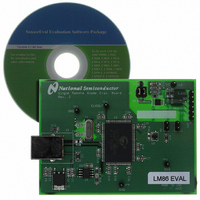LM86EVAL/NOPB National Semiconductor, LM86EVAL/NOPB Datasheet - Page 19

LM86EVAL/NOPB
Manufacturer Part Number
LM86EVAL/NOPB
Description
BOARD EVALUATION LM86
Manufacturer
National Semiconductor
Specifications of LM86EVAL/NOPB
Sensor Type
Temperature
Sensing Range
0°C ~ 125°C
Interface
SMBus (2-Wire/I²C)
Sensitivity
±1°C
Voltage - Supply
3 V ~ 3.6 V
Embedded
No
Utilized Ic / Part
LM86
Lead Free Status / RoHS Status
Lead free / RoHS Compliant
Other names
Q3975531
3.0 Application Hints
3.2 PCB LAYOUT for MINIMIZING NOISE
In a noisy environment, such as a processor mother board,
layout considerations are very critical. Noise induced on
traces running between the remote temperature diode sen-
sor and the LM86 can cause temperature conversion errors.
Keep in mind that the signal level the LM86 is trying to
measure is in microvolts. The following guidelines should be
followed:
1. Place a 0.1 µF power supply bypass capacitor as close
2. The recommended 2.2nF diode bypass capacitor actu-
3. Ideally, the LM86 should be placed within 10cm of the
4. Diode traces should be surrounded by a GND guard ring
as possible to the V
capacitor as close as possible to the LM86’s D+ and D−
pins. Make sure the traces to the 2.2nF capacitor are
matched.
ally has a range of TBDpF to 3.3nF. The average tem-
perature accuracy will not degrade. Increasing the ca-
pacitance will lower the corner frequency where
differential noise error affects the temperature reading
thus producing a reading that is more stable. Con-
versely, lowering the capacitance will increase the cor-
ner frequency where differential noise error affects the
temperature reading thus producing a reading that is
less stable.
Processor diode pins with the traces being as straight,
short and identical as possible. Trace resistance of 1Ω
can cause as much as 1˚C of error. This error can be
compensated by using the Remote Temperature Offset
Registers, since the value placed in these registers will
automatically be subtracted from or added to the remote
temperature reading.
to either side, above and below if possible. This GND
guard should not be between the D+ and D− lines. In the
event that noise does couple to the diode lines it would
be ideal if it is coupled common mode. That is equally to
FIGURE 15. Ideal Diode Trace Layout
DD
pin and the recommended 2.2 nF
(Continued)
10130317
19
5. Avoid routing diode traces in close proximity to power
6. Avoid running diode traces close to or parallel to high
7. If it is necessary to cross high speed digital traces, the
8. The ideal place to connect the LM86’s GND pin is as
9. Leakage current between D+ and GND should be kept
Noise coupling into the digital lines greater than 400mVp-p
(typical hysteresis) and undershoot less than 500mV below
GND, may prevent successful SMBus communication with
the LM86. SMBus no acknowledge is the most common
symptom, causing unnecessary traffic on the bus. Although
the SMBus maximum frequency of communication is rather
low (100kHz max), care still needs to be taken to ensure
proper termination within a system with multiple parts on the
bus and long printed circuit board traces. An RC lowpass
filter with a 3db corner frequency of about 40MHz is included
on the LM86’s SMBCLK input. Additional resistance can be
added in series with the SMBData and SMBCLK lines to
further help filter noise and ringing. Minimize noise coupling
by keeping digital traces out of switching power supply areas
as well as ensuring that digital lines containing high speed
data communications cross at right angles to the SMBData
and SMBCLK lines.
4.0 Data Sheet Revision History
Date
4/2003
the D+ and D− lines.
supply switching or filtering inductors.
speed digital and bus lines. Diode traces should be kept
at least 2cm apart from the high speed digital traces.
diode traces and the high speed digital traces should
cross at a 90 degree angle.
close as possible to the Processors GND associated
with the sense diode.
to a minimum. One nano-ampere of leakage can cause
as much as 1˚C of error in the diode temperature read-
ing. Keeping the printed circuit board as clean as pos-
sible will minimize leakage current.
Revision
1. Added improved guaranteed Temperature
2. in
3. Changed numbering of "Applications Hints"
4. Added "4.0 Data Sheet Revision History"
Error specification for the Remote Diode
Readings of
Electrical Characteristics.
"11hexadecimal or 17 decimal"
from "4." to "3."
section.
Section
2.13
±
0.75
o
C to page 1 and
changed
www.national.com
"21h"
to










